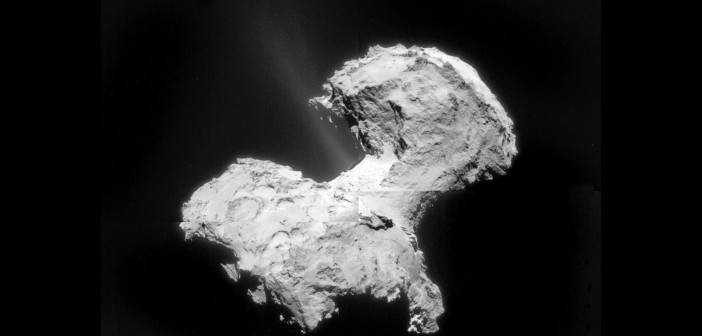Comet 67P/Churyumov–Gerasimenko — made famous by the explorations of the Rosetta mission — has been displaying puzzling activity as it hurtles toward the Sun. However, recent modeling of the comet by a group of scientists from the Côte d’Azur University may now explain what’s causing 67P’s activity.
Shadowed Activity

A model of comet 67P, with the colors indicating the rate of change of the temperature on the comet’s surface. The most rapid temperature changes are seen at the comet’s neck, in the same locations as the early activity seen in the Rosetta images. [Alí-Lagoa et al. 2015]
The authors of a recent study, led by Victor Alí-Lagoa, hypothesize that it’s precisely because the neck is receiving alternating sunlight/shadows that it’s displaying activity. They suggest that thermal cracking of the surface of the comet is happening faster in this region, due to the rapid changes in temperature that result from the shadows cast by the surrounding terrain. The cracking exposes subsurface ices in the neck faster than in other regions, and the ensuing sublimation of that ice is what creates the activity we’re seeing.
Temperature Models
To test their hypothesis, the authors study the surface temperatures on comet 67P by means of a thermophysical model — a model used to calculate the temperatures on an airless body, both on and below the surface. The model takes into account factors like thermal inertia (how quickly the body’s temperature responds to changes in the incident energy), shadowing, and self-heating between parts of the surface in contact.

Plot of the modeled temperature of two typical surfaces on the comet: one from the neck region (solid line) and one from the head region (dashed line). Unlike the head, the neck displays drastic drops in temperature as a result of shadowing. [Alí-Lagoa et al. 2015]
Should this model prove correct, it’s a step toward understanding the evolution of comets like 67P. In addition, the results from this study imply that thermal cracking might happen faster than previously estimated in shadowed regions of other atmosphereless bodies, both near Earth and in the asteroid belt.
Citation
V. Alí-Lagoa et al 2015 ApJ 810 L22. doi:10.1088/2041-8205/810/2/L22
